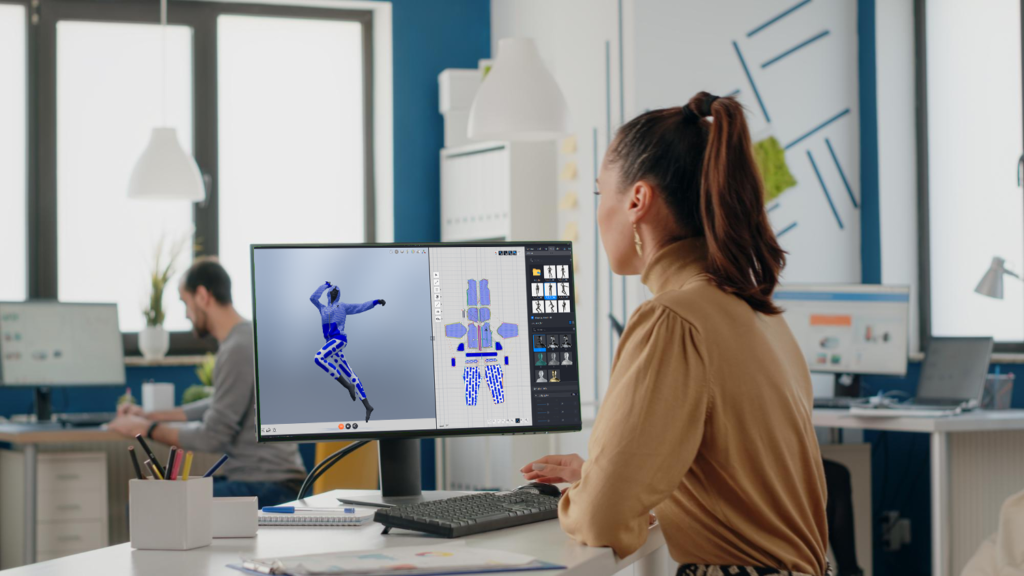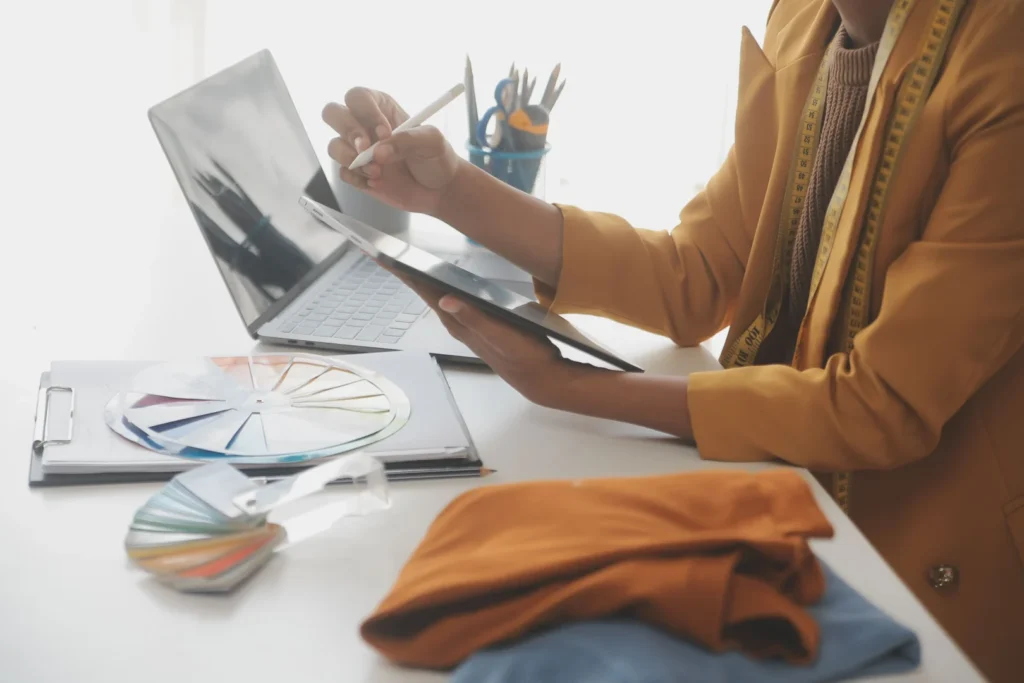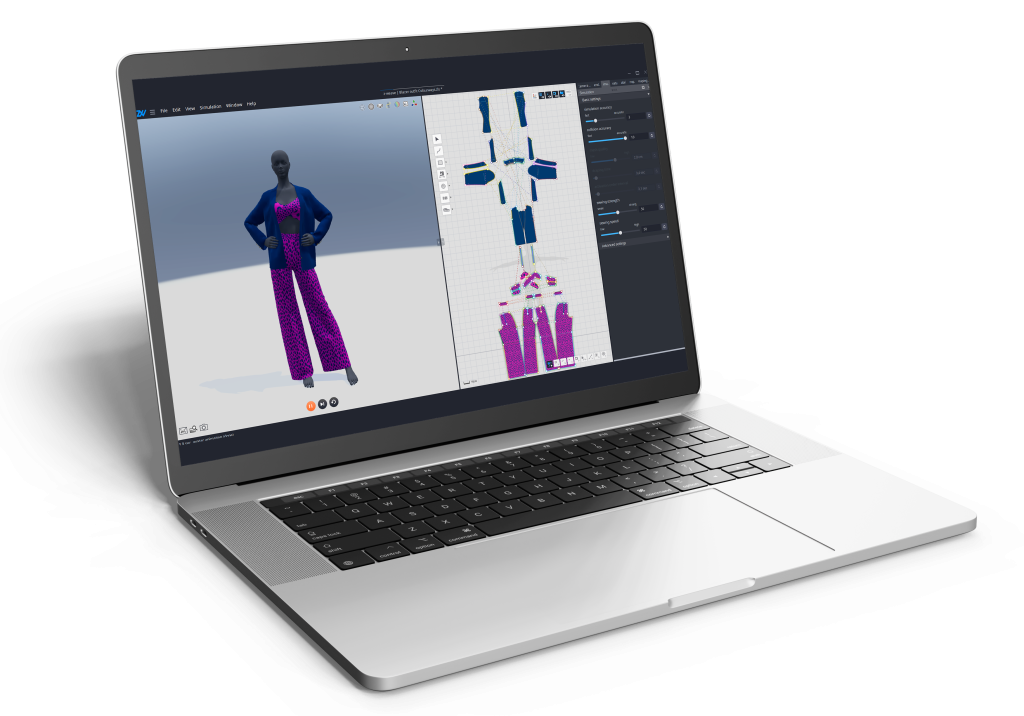Summary
- Technology is continuously transforming the lives of apparel manufacturers, streamlining their business processes and driving growth.
- Among these advancements, 3D modeling software stands out as a revolutionary force, reshaping the fashion industry.
- Still unsure how they can boost your business results? Try Audaces360 multisolution for free today!
Gone are the days when terms like “3D modeling software” and “rendering” were solely associated with architectural and engineering projects.
Today, these technologies are revolutionizing the fashion industry, with top brands like Nike and Levi’s, fast fashion giants like Lidl and Mango, and luxury houses like Hugo Boss and Emilio Pucci embracing them to optimize their processes.
But don’t assume that this technology is only accessible to large companies! 3D technology is now affordable for all types of fashion businesses and has the potential to revolutionize yours as well.
Discover how with our content!
Sumário
Why optimize developing processes with 3D modeling software?
There’s a compelling reason why fashion manufacturers of all sizes are investing heavily in 3D modeling software.
Imagine a time when the automation of the development process relied on creating vector patterns directly on the computer, instead of on paper.
This is already a significant step forward, as it enables the creation of more precise patterns, with more proportional size grading and reduced time.
However, these digital patterns still needed to be physically transferred to the real world for testing on fabrics.
Creating physical garment samples was the only way to try the movement of the fabric, its fit on the body, the combination of colors, and all the definitive elements that would determine whether a product was approved or not.
With the advent of 3D modeling software, these patterns are taking longer to leave the digital space. This is because they can be automatically tested on a three-dimensional mannequin.
With this solution, it is possible to test the patterns and check the drape of the garment without cutting a single piece of fabric.
Think about the valuable time and the reduction of raw material waste that this promotes!
All of this speeds up the development time of an item, which improves workflow and allows products to be launched on the market much earlier.
3D modeling software also allows designers to create detailed and realistic representations of their garments, enabling them to visualize and refine designs more effectively.
This capability helps identify and address design issues early on, minimizing errors and ensuring a high-quality final product.
Companies can benefit by gaining a competitive edge, improving product quality, and ultimately achieving greater success by adopting cutting-edge technology in the ever-evolving fashion industry.
Learn more: How to choose the best fashion CAD for your business
What features should a good 3D modeling software have?
To find out what is the best software for creating 3D models, carefully evaluate essential factors that align with your needs and effectively replace your current business processes.
Additionally, there are numerous other benefits to consider when adopting 3D modeling software.
Here are some other aspects to evaluate to fully maximize the potential of this kind of solution:
Customized mannequin poses
Beyond the widely recognized advantage of 3D modeling software, which is the ability to test designs virtually on a computer, there is another powerful benefit: exploring different mannequin poses.
Most 3D modeling software packages come equipped with a comprehensive library of mannequins and pre-defined poses, providing a diverse range of options to showcase your creations.
However, the real magic lies in the ability to personalize your own unique mannequins and poses, tailored to your specific needs and vision.
The poses you choose for your mannequins play a pivotal role in conveying the essence and style of your garments.
Rendering images from these posed mannequins allows you to create captivating visuals for marketing and sales campaigns.
In simpler terms, rendering is like taking a raw blueprint or sketch and transforming it into a polished, photorealistic representation.
It involves applying various techniques, such as lighting, shading, textures, and reflections, to create a realistic and visually appealing outcome.
Different poses can effectively communicate the concept and intended use of your garments.
For example, dynamic poses are ideal for sportswear, while elegant, angled poses perfectly complement sophisticated collections.
The possibilities are endless, allowing you to craft compelling visual narratives for your brand.
Learn more: Explore the power of art posing and personalized sketches in fashion
Simulated prints, textures, and drape

Before showcasing your collections with stunning imagery, 3D modeling software proves to be an invaluable asset for your design and development teams.
By meticulously controlling lighting and background settings within the virtual environment, designers can analyze every intricate detail of a garment, from prints to fabric drapes.
Modern 3D modeling solutions offer a comprehensive library of pre-designed prints to inspire creativity.
However, designers can seamlessly integrate their own custom designs into the system, allowing for a virtual preview of patterns on various garment models.
This eliminates the need for physical fabric samples, saving time, reducing waste, and enabling informed decisions early in the design process.
The same is valid for textures — designers can visualize how textures interact with each other, how they complement the garment’s fit on the body, and how they contribute to the overall aesthetic.
This realistic simulation allows for fine-tuning textural combinations before committing to physical samples.
Finally, 3D modeling software also offers an unprecedented level of realism in predicting fabric drapes, allowing for the visualization of how a fabric will fit and behave on the body.
This level of detail empowers designers to refine their creations and minimize the risk of costly mistakes later in the production process.
Learn more: 6 tips on how to draw a shirt using technology
100% digital design approval
The meticulous examination of every detail – from patterns and textures to fabric drapes and fit – empowers you to digitally approve your entire collection with complete confidence.
Before any piece of fabric is cut, you can review every aspect of your designs, ensuring that proportions, patterns, seams, colors, fabrics, and textures are exactly as envisioned.
With 3D modeling software, the physical garment only needs to leave the digital realm when it’s virtually perfect.
It eliminates the need for multiple physical samples, allowing you to create just one instead – a significant improvement over the traditional method.
This approach translates to significant time and resource savings since the final physical sample is already close to your vision.
Thanks to the digital refinement process, there’s less back-and-forth between design and production, minimizing the need for revisions and streamlining the entire development process.
Learn more: 5 strategies to optimize your production with efficient fashion
Key benefits of using 3D modeling software in your apparel manufacturing
Now that you understand the key features of good 3D modeling software, let’s explore the major benefits your fashion company can gain by investing in this technology.
1) Design freedom
One of the most significant advantages of 3D modeling software for fashion designers is the unparalleled creative freedom it unlocks.
Unlike the limitations imposed by physical samples, 3D modeling allows designers to effortlessly create variations of garments with just a few clicks.
This agility opens doors to a world of possibilities, allowing for the visualization of how a single design concept could be translated into different fabrics, colors, and lengths, for example.
In the realm of 3D, testing and refining design ideas becomes effortless. By contrast, creating multiple variations with physical samples can be time-consuming and resource-intensive.
This freedom to explore fuels creativity and empowers innovation, ultimately leading to the possibility of innovative designs.
Learn more: Explore the role and benefits of a virtual fashion designer
2) Enhanced precision and detailing
One of the most impressive aspects of 3D modeling software is the remarkable level of detail it offers.
Unlike traditional design methods, where visualizing intricacies can be challenging, 3D software allows designers to zoom in and meticulously examine every aspect of their creation.
This includes the ability to review seams, analyze how the fabric drapes and interacts with the body in different poses, and even simulate the fabrics’ movements.
Learn more: Discover the functionality and benefits of 3D fabric to fashion
3) Efficient testing and prototyping

With 3D modeling software, you can seamlessly transition your entire approval process to digital.
This approach involves testing the 2D patterns created by the designer on a 3D mannequin, providing an unparalleled level of precision and efficiency.
The technology empowers you to meticulously test every aspect of your design, from cuts and seams to finishes, gathers, pleats, and folds.
Every detail envisioned by the designer and meticulously crafted by the pattern maker can be replicated in the 3D environment, allowing for comprehensive testing and prototyping with confidence and precision.
Learn more: 4 key steps to streamline your fashion production process
4) Reduced operational costs
You already know that 3D modeling software empowers your fashion company to cut production costs through digital prototyping.
But that’s not all! 3D prototypes also facilitate clear communication across design, patternmaking, and production teams.
Everyone can visualize the design in 3D, reducing misunderstandings and errors that might require costly rework on physical samples.
By embracing 3D modeling, you gain a significant edge in cost reduction. Fewer physical samples translate to less material waste, reduced production time, and minimized errors.
This streamlined and efficient design process ultimately leads to a more cost-effective operation for your apparel manufacturing.
Learn more: How mass production can boost your apparel manufacturing results
5) Raw material savings
Physical samples often require significant amounts of fabric, contributing to material waste and associated expenses.
Who has never had the frustration of running out of a key fabric for your collection due to excessive sample creation?
3D prototyping eliminates this concern.
By testing and refining designs digitally, you can accurately calculate the required fabric quantity, ensuring you have enough material to complete your collection without costly shortages or delays.
With digital prototyping, you can test and refine your designs virtually, eliminating the need for multiple physical samples and conserving valuable fabric resources.
Adopting 3D modeling software not only optimizes your design process and reduces costs but also aligns with a more sustainable approach to fashion.
By minimizing material waste and streamlining production, you can contribute to a more environmentally conscious fashion industry.
In essence, 3D modeling software empowers your fashion company to operate with greater efficiency, reduce costs, and embrace a more sustainable future.
Learn more: Discover how sustainable design can delight your customers
Create your 3D patterns with Audaces’ solutions

By now, you should be aware of the benefits of 3D modeling software and how it can revolutionize your processes and be the missing piece in your business growth.
To take this step, rely on the specialized help of Audaces, a leading fashion technology company that develops solutions to facilitate every stage of the textile and fashion creation, development, and production process worldwide.
Audaces Pattern
Audaces Pattern is the ideal solution for creating digital patterns. It allows for easy development of new patterns with intuitive tools that help you avoid mistakes.
Create your patterns with high quality and precision, ensuring the correct development of all sizes, regardless of the level of complexity and number of details.
It works in an integrated way with other Audaces360 solutions, our complete suite of tools for the fashion industry.
Audaces 3D
With Audaces 3D, you can virtually test the patterns created in Audaces Pattern. They work in an integrated way and were created to revolutionize and facilitate the way your company develops new products.
Make your company more sustainable by ensuring the precision of details, fit, and measurements with digital prototypes.
With this solution, it is possible to generate rendered images to use in your campaigns and integrate with e-commerce, elevating the experience of your customers.
Personalized consulting
Through our personalized consulting service, you can discover how to take your business to the next level.
Our team of experts will carry out a detailed analysis of your business and diagnose the right investments for you to achieve your goals.
Maximize your growth potential! Request your free personalized consultation today.
FAQ
With this solution, it is possible to test the patterns and check the drape of the garment without cutting a single piece of fabric.
Customized mannequin poses, simulated prints, textures, and drape, and 100% digital design approval.
Design freedom, enhanced precision and detailing, efficient testing and prototyping, reduced operational costs, and raw material savings.










